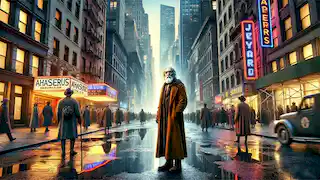The Legend of the Wandering Jew
Reading time: 7 min

About this story: The Legend of the Wandering Jew is a Legend from Israel set in the Ancient This Dramatic tale explores themes of Redemption and is suitable for Adults. It offers Inspirational insights. A timeless journey of redemption, faith, and humanity’s eternal quest for meaning.
Throughout the vast corridors of time and across the shifting sands of history, there has been a legend that has intrigued, frightened, and mystified countless generations. This is the story of the Wandering Jew, a figure cursed with immortality, destined to roam the earth until the end of time. It is a tale that intertwines themes of penance, sorrow, redemption, and the human desire for meaning. This legend, echoing through different cultures and evolving across eras, continues to raise questions about faith, humanity, and the eternal struggle for forgiveness.
A Night in Jerusalem
In the year 33 AD, Jerusalem was alive with whispers of a prophet, a man from Nazareth who had gathered a devoted following. The city, with its labyrinth of stone streets and bustling markets, stood tense as rumors spread that this man, Jesus of Nazareth, was facing trial. Among the crowd was a cobbler named Ahasuerus, who observed with disinterest the mounting excitement.
That morning, as the sun struggled to pierce through a shroud of gray clouds, Ahasuerus stood at the doorway of his modest shop. He saw the Roman soldiers dragging a bloodied figure, wearing a crown of thorns, towards Golgotha, the place of execution. The sight might have stirred sympathy in some, but to Ahasuerus, it was merely another day.
As the condemned man stumbled, he paused before Ahasuerus' door, seeking a moment's respite. With a sneer, Ahasuerus spat, "Go on! Move faster! Why do you linger here?" The words were heavy with disdain. The figure looked up, eyes brimming with sorrow and wisdom, and spoke, "I go, but you shall wait until I return."
With those words, a chill pierced Ahasuerus' heart. He tried to shake off the unease, but it clung to him like a shadow. As the crowd moved on, he felt an inexplicable sensation—a sense of being anchored to the world, unable to escape.
The First Signs of the Curse
Weeks passed, then months, and Ahasuerus began to notice strange changes. While those around him aged, he remained the same. Decades flowed by, and his skin did not wrinkle, his hair did not gray, and he felt neither the ailments of old age nor the embrace of death.
He wandered the lands of Judea, then farther still, searching for answers. He sought out rabbis, priests, and scholars, but no one could offer him solace. It was during one such journey, standing at the foot of Mount Sinai, that he met an old man who listened to his tale with a knowing smile.
"Yours is a burden not meant to be borne by mortal man," the sage said. "You mocked the One who bore the world's suffering, and now you are condemned to walk without rest. Perhaps you seek redemption, but that is a journey of countless lifetimes."
From that moment, Ahasuerus accepted that his fate was to wander, seeking an end to his suffering yet unable to find it.

Across Centuries and Continents
Time passed, and the world changed around Ahasuerus. He walked through the Roman Empire's golden age, saw it crumble, and witnessed the rise and fall of kingdoms. The Crusades swept across the land, and the Black Death left a trail of devastation, but still, he wandered, untouched by disease or war.
In the year 1349, during the peak of the plague in Europe, Ahasuerus found himself in a small village in Germany. The villagers, fearing him as an omen of death, captured and imprisoned him, believing that by burning him, they could rid themselves of the plague. Bound to a wooden stake, he felt the flames lick at his flesh. He cried out, not in pain, but in despair, longing for an end. Yet, as the fire consumed him, his body healed, and he stood unscathed as the villagers watched in horror.
With a voice that echoed beyond the flames, he whispered, "I cannot die."
Word of his immortality spread, and the legend of the Wandering Jew grew. Some sought him for wisdom, others to test the limits of his curse. But no matter where he traveled—be it the palaces of Europe, the deserts of Arabia, or the forests of Africa—his soul remained restless, forever longing for the release that never came.
A Glimpse of Hope
By the 17th century, Ahasuerus found himself in Amsterdam. Here, he met Baruch Spinoza, a philosopher whose thoughts on God, nature, and existence resonated deeply with him. In Spinoza's company, Ahasuerus found a rare moment of peace. They would walk the canals at night, discussing the nature of suffering and the quest for redemption.
"Perhaps," Spinoza once mused, "it is not forgiveness that you seek, but understanding. The journey you are on might not be a curse but a path towards enlightenment. Have you considered that your immortality is an opportunity to witness the unfolding story of humanity?"
Ahasuerus pondered this idea. Could his endless wandering be more than punishment? Could it be a chance to bear witness to humanity’s growth and learn from it? For the first time in centuries, a spark of hope ignited within him.
Yet, as the decades rolled by, that hope flickered. He watched as wars raged on, as humanity seemed doomed to repeat its mistakes. Each era brought new horrors, and his longing for an end deepened.
{{{_02}}}
The Modern Age and the Quest for Redemption
As the 20th century dawned, Ahasuerus walked the streets of New York City, blending in with the bustling crowds. Here, in this modern Babylon, he encountered both the wonders and horrors of a new age. He saw skyscrapers reach towards the heavens, and he felt the rumble of tanks as World War I turned the world to ashes. He stood in silent witness as the Holocaust unfolded, and he wept, for in those horrors, he saw echoes of his own curse—an endless cycle of suffering.
It was in the aftermath of the Second World War that Ahasuerus met a young Jewish woman named Miriam. She had survived the concentration camps and bore the scars of that dark time. But in her eyes, there was light. Miriam spoke of faith, hope, and the resilience of the human spirit.
"Why do you continue to wander?" she asked one evening as they walked through Central Park. "Why not find a way to live, even if it is for eternity?"
He pondered her words deeply, more deeply than any other he had heard in two millennia. And it was then he realized that perhaps, just perhaps, the journey towards redemption lay not in finding an end but in discovering a purpose.
The Eternal Pilgrimage
In the years that followed, Ahasuerus found himself standing before the Western Wall in Jerusalem, his journey coming full circle. He placed his hand on the ancient stones, feeling the weight of centuries pressing back against him. It was here that he understood—redemption wasn't about ending his journey but about embracing it.
He would continue to wander, but now, he would do so with purpose. He would share his story, his knowledge, and his experiences, hoping to guide others away from the paths of hatred, ignorance, and suffering that he had witnessed.
And so, the Wandering Jew continued his journey, not as a figure cursed to roam the earth but as a pilgrim searching for truth, understanding, and a way to make his endless existence meaningful.

Epilogue: The Legend Lives On
Today, some say the Wandering Jew still roams, disguised as a traveler in an airport lounge, a stranger in a café, or a mysterious old man wandering the streets of a city that never sleeps. His eyes carry the weight of countless ages, yet there's a hint of light within them—a spark that speaks of hope, redemption, and the endless search for meaning.
For as long as there are questions of faith, forgiveness, and the human journey, the legend of the Wandering Jew will continue. And perhaps, somewhere out there, he still walks among us, waiting for the day when he can finally rest.



















